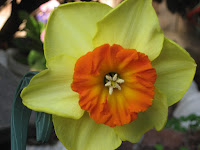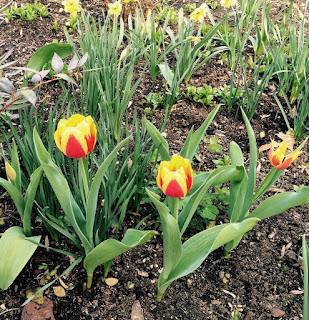
|
|
Tulips and hyacinths need chill time
to bloom again.
(Photo: Debbie Arrington)
|
October is prime planting time for spring favorites
Some spring bulbs you can plant and forget; they’ll take care of themselves year after year. The one prerogative: Planting at the right time.
In Sacramento where the ground never freezes, bulb planting time runs October through mid-December. To help stagger bloom through next spring, stagger planting, too. Plant bulbs every two to three weeks instead of all at once.
Daffodils and the whole narcissus family can be put directly into the ground now. So can alliums, amaryllis, anemones, Dutch iris, freesia, ixias, ranunculus, scillas, sparaxis and several other bulbs native to temperate climates.
Other bulbs need some advance planning and cold to bloom their best. In particular, tulips and hyacinths need chill time before planting in most of California.
Chill time replicates the hours bulbs spend waiting for winter to end, preferably between 40 and 45 degrees F. That’s the same range as the refrigerator crisper drawer. (Avoid chilling bulbs in the same drawer as apples or pears; the fruit releases gases that will cause the bulbs to rot.)
How much chill do these bulbs need? The standard in Sacramento is six to eight weeks; in Southern California, it’s 10 to 12 weeks. The warmer the winter, the more weeks in the refrigerator required.

|
|
Daffodil and narcissus varieties
can be planted now, but stagger
plantings for the best show in
spring.
(Photo: Kathy Morrison)
|
According to bulb expert Colorblends, more is better when it comes to pre-chilling, recommending up to 15 weeks. Bulbs bought in August can be chilled until December. (As far as the tulips know, it was just a long, cold winter.)
Gardeners think of large flowering tulips as Dutch but these prized bulbs are actually native to Siberia, inner Mongolia and the western Himalayas. A need to feel winter chill is part of their DNA.
But tulips are part of a large family with about 75 species, some native to Turkey and the Middle East. Those species tulips (mostly dwarf or multi-flower varieties) bloom with less cold and year after year without replanting.

|
|
Tulip bulbs can be pre-chilled in the fridge
up to 15 weeks
before planting --
just
don't store them with apples
or pears. (Photo: Kathy Morrison)
|
Hybridization also has brought down the chill requirements for some varieties such as the popular Darwin tulips.
Through many years of experimentation, I’ve found that hyacinths and Darwin tulips will rebloom without re-chilling and replanting in Sacramento. The key was to expose the bulbs to more cold in winter outdoors.
Cued by temperature, tulips need soil under 60 degrees to rest and develop their roots. When temperatures hit 68 degrees, they send up leaves.
By planting in containers, tulips feel more chill than if planted directly in the ground. I also store those containers fully planted in the coldest spots in the garden (north side of the house, fully shaded), then move them into place on the sunny patio in January.
For example, these Darwin tulips and grape hyacinths are planted in essentially a large redwood box. They’ve been in this same box at least five years and bloom every spring. (I did pre-chill them before their original planting.) They get a little bone meal in early February and I lifted them once to replenish the soil. But that’s it.
What if you forget the bulbs in fridge? Plant them as late as February or early March and they’ll still (maybe) bloom in April. They’ll be shorter and smaller, but they’ll try to flower.
If you pre-chill bulbs, make yourself a note. Mark on your calendar when you put the tulips in the fridge and when you should take them out. You’ll thank yourself next spring.


